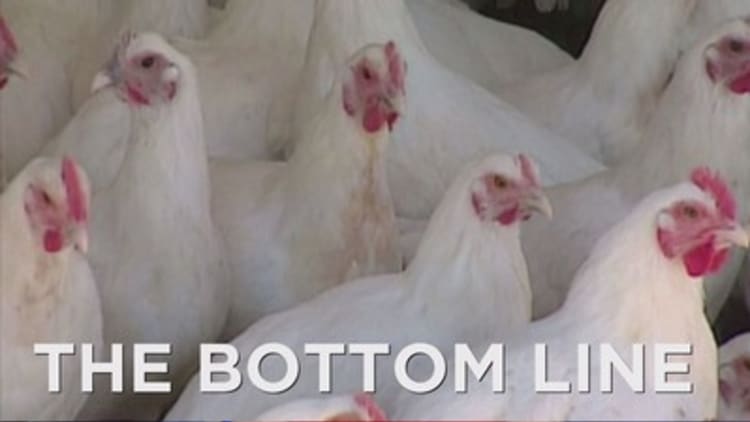
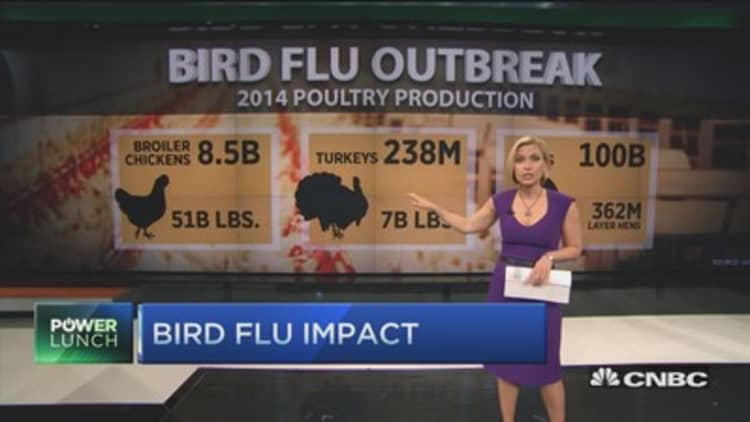
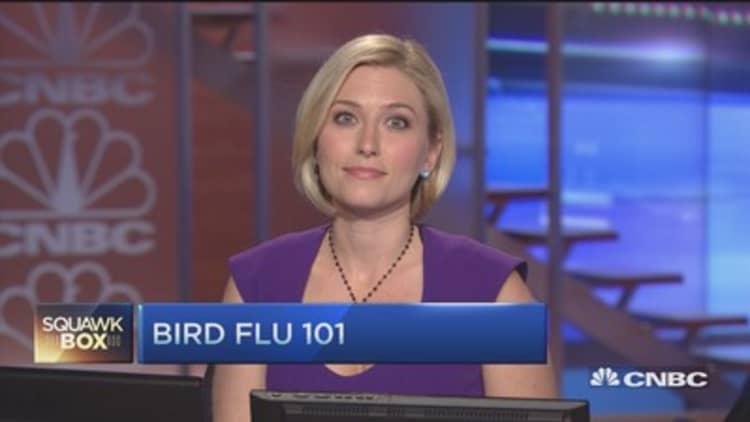
The costly effects of a virulent H5 strain of avian influenza keeps getting worse. Layoffs have begun in the poultry industry as thousands more birds are being slaughtered.
The U.S. Department of Agriculture has now confirmed 122 cases of the disease, which can kill a bird in 48 hours (Tweet This). So far, nearly 24 million chickens and turkeys from more than a dozen states have been affected since December. The mounting numbers top the previous record outbreak from the 1980s, which hit 17 million birds.
And it's still spreading: Both Iowa and Minnesota reported more "probable" cases this week, including two more commercial egg operations that together house an estimated 3.9 million hens.
Egg producers have been hit hardest. In 2014, 362 million "layer" hens in the U.S. produced 100 billion eggs. With more than 20 million hens now in the process of being culled, nearly 6 percent of the nation's population has been taken offline.
Layer hens are different from "broiler" chickens, which are sold as meat.
Read More "So far, this is a turkey and egg story, not a broiler story," said David Maloni, president and chief commodity strategist of the American Restaurant Association.
Based on current cases, Maloni forecasts wholesale egg prices will rise by 15 cents per dozen. "We were looking for a 5 percent decline in egg prices in 2015 versus 2014 due to better production," he said. "But now we've just increased our egg price forecast by about 15 cents per pound, which would put egg prices maybe down only 1 percent."
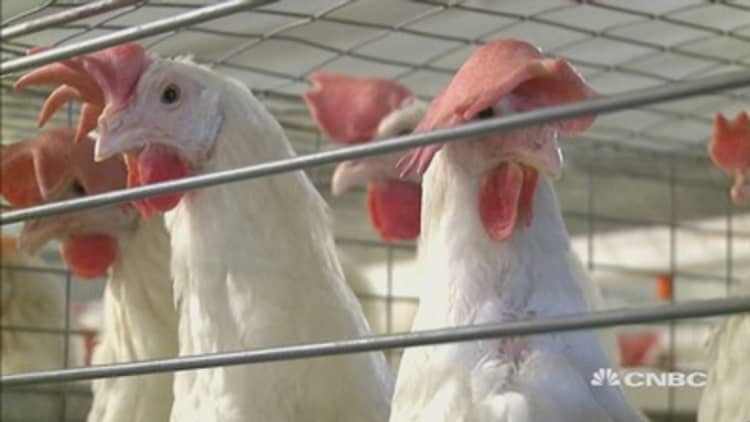
The turkey market has also been pummeled. U.S. farmers raised 238 million birds last year; roughly 1.5 percent of that supply has been hit. Still, experts don't expect turkey prices to rise—yet.
"From December until August, we're usually building [turkey] stocks, and so far this year, we've actually built stocks at about an average pace, so there's no concern yet," said Maloni. "A signal for us for higher prices would be a less-than-usual build over the next few months."
"You aren't going to see the $5 footlongs offered at Subway," said Joseph Kerns, president of Kerns and Associates, an industry consultant. "The bigger impact will be in the fall coming into Thanksgiving."
Read More
On Tuesday, the Jennie-O Turkey Store subsidiary of Hormel Foods said it's and cutting back to a single processing shift at its Faribault, Minnesota, plant due to bird flu.
"This will be a temporary layoff and our intent is to have everyone come back to work when bird numbers return to normal levels," plant manager Randy Vergin said in a statement. "We do not have an anticipated return to work date at this time, but look forward to welcoming our team members back when production levels return to normal."
The announcement comes weeks after Hormel warned investors that turkey sales in its Jennie-O segment could be hampered this year due to "significant challenges" in its supply chain, an issue that could push full-year earnings to the lower end of previous guidance.
Shares of Hormel have risen about 5.7 percent this year.
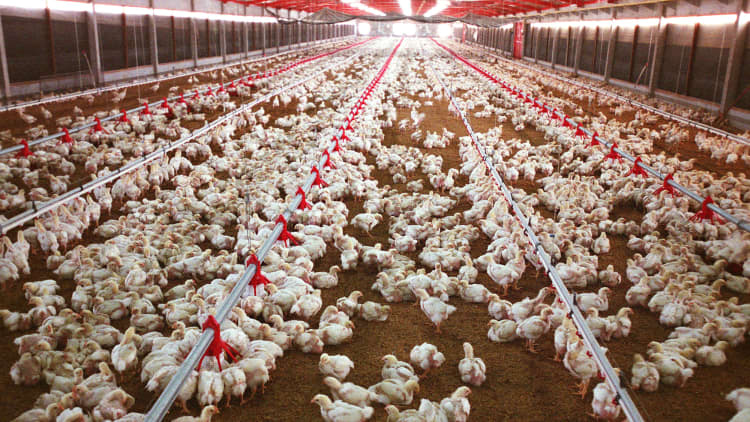
Experts are closely watching reproductive flocks of chickens and turkeys, some of which have also been infected, but not nearly to the same extent as layer hens. If more young birds are taken out of the system, that could create a shortage in the second half of the year as farmers struggle to repopulate their flocks.
Broiler chicken, the largest segment of the country's $48 billion-per-year poultry market, has been largely unaffected by this bout of bird flu. Comprising 68 percent of the overall poultry market, broilers—chickens raised for meat—were an 8.5-billion-bird business in the U.S. last year.
Industry experts say broilers have been insulated for two reasons: location, since the top producers are in the Southeast; and tight biosecurity, since the industry already had strict protective measures in place.
Read MoreCramer: Warren Buffett's biggest diet nightmare
But even broilers aren't immune to the effects of the flu. As cases mount, some countries have imposed bans or restrictions on poultry imports from the United States, including two of the industry's biggest trade partners, China and Mexico. That's weighing on demand for chicken, particularly the leg quarters, or dark meat, which is predominantly what's shipped overseas.
On a recent earnings call, Tyson Foods executives stressed that the chicken processor's supply has not been affected, since the broiler industry has remained largely untouched by the outbreak. Still, it's feeling the ripple effects as top export markets enact bans or restrictions due to bird flu.
"At this point, the primary impact on our business is not from bird health concerns, but rather from the loss of export markets for certain states and the resulting excess leg quarters [dark meat chicken] in the domestic market," the company said. "We've positioned ourselves well over the past several years by reducing our dependency on export leg quarters which now represent only a smaller percentage of our total portfolio."
It's something the entire food industry is watching closely–whether they've been affected yet or not. Panera Bread chief executive Ron Shaich told CNBC that the fast casual chain has not experienced issues with its turkey supply, but that "if there is a serious problem with the bird flu it could cause serious problems for all of us in the restaurant industry—and for consumers."
No threat to humans, government says
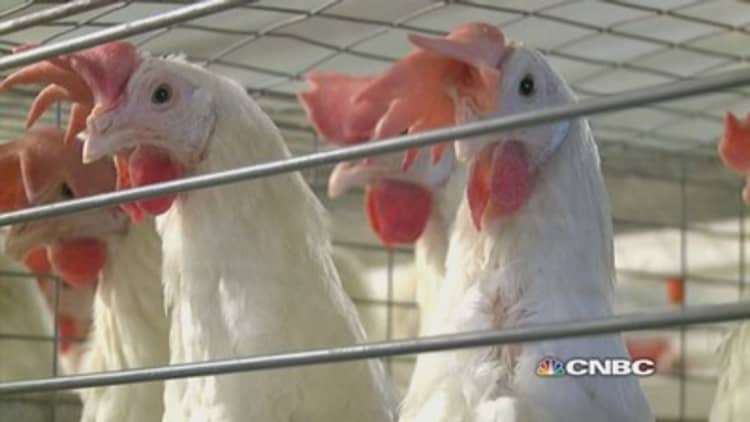
No human cases of the H5N2 strain have been detected, and federal officials continue to say the virus, in its current state, poses little risk to human health. The USDA maintains that the flu has not made its way into the food supply. Even if it did, the agRead Moreency says, it would be killed off through the proper preparation of poultry products. To be safe, officials are administering antiviral medications to farm workers who have been exposed to the virus.
The USDA is trying to develop a vaccine against the H5 bird flu strains. The CDC has said it is closely studying the virus and researching a possible human vaccine as well.
Read MoreUS poultry exports plunge with avian flu scare
Scientists believe the virus is being spread by migratory waterfowl as they make their seasonal trek north along the flyways. One possible means of transmission may be workers tracking the virus via droppings on their shoes.
The federal government has authorized the transfer of an additional $330 million in emergency funds to the USDA to help it deal with the epidemic, on top of $84.5 million earmarked previously. That cash pile is expected to be used for indemnity claims from producers who have had to quarantine their facilities and destroy flocks—an extremely costly process that can take months.
In addition to Iowa, Wisconsin and Minnesota have declared states of emergency to combat the escalating epidemic.


